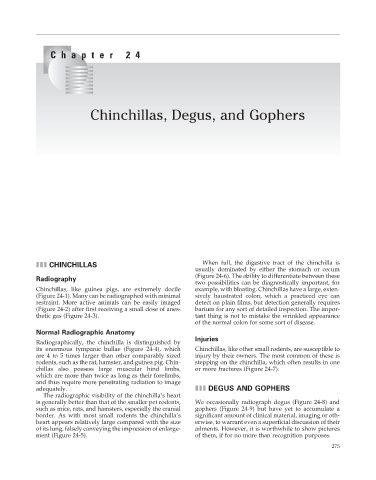Page 279 - Veterinary diagnostic imaging birds exotic pets wildlife
P. 279
Chapter 24
Chinchillas, Degus, and Gophers
III CHINCHILLAS When full, the digestive tract of the chinchilla is
usually dominated by either the stomach or cecum
(Figure 24-6). The ability to differentiate between these
Radiography
two possibilities can be diagnostically important, for
Chinchillas, like guinea pigs, are extremely docile example, with bloating. Chinchillas have a large, exten-
(Figure 24-1). Many can be radiographed with minimal sively haustrated colon, which a practiced eye can
restraint. More active animals can be easily imaged detect on plain films, but detection generally requires
(Figure 24-2) after first receiving a small dose of anes- barium for any sort of detailed inspection. The impor-
thetic gas (Figure 24-3). tant thing is not to mistake the wrinkled appearance
of the normal colon for some sort of disease.
Normal Radiographic Anatomy
Injuries
Radiographically, the chinchilla is distinguished by
its enormous tympanic bullae (Figure 24-4), which Chinchillas, like other small rodents, are susceptible to
are 4 to 5 times larger than other comparably sized injury by their owners. The most common of these is
rodents, such as the rat, hamster, and guinea pig. Chin- stepping on the chinchilla, which often results in one
chillas also possess large muscular hind limbs, or more fractures (Figure 24-7).
which are more than twice as long as their forelimbs,
and thus require more penetrating radiation to image
adequately. III DEGUS AND GOPHERS
The radiographic visibility of the chinchilla’s heart
is generally better than that of the smaller pet rodents, We occasionally radiograph degus (Figure 24-8) and
such as mice, rats, and hamsters, especially the cranial gophers (Figure 24-9) but have yet to accumulate a
border. As with most small rodents the chinchilla’s significant amount of clinical material, imaging or oth-
heart appears relatively large compared with the size erwise, to warrant even a superficial discussion of their
of its lung, falsely conveying the impression of enlarge- ailments. However, it is worthwhile to show pictures
ment (Figure 24-5). of them, if for no more than recognition purposes.
275
2/11/2008 11:11:43 AM
ch024-A02527.indd 275
ch024-A02527.indd 275 2/11/2008 11:11:43 AM

